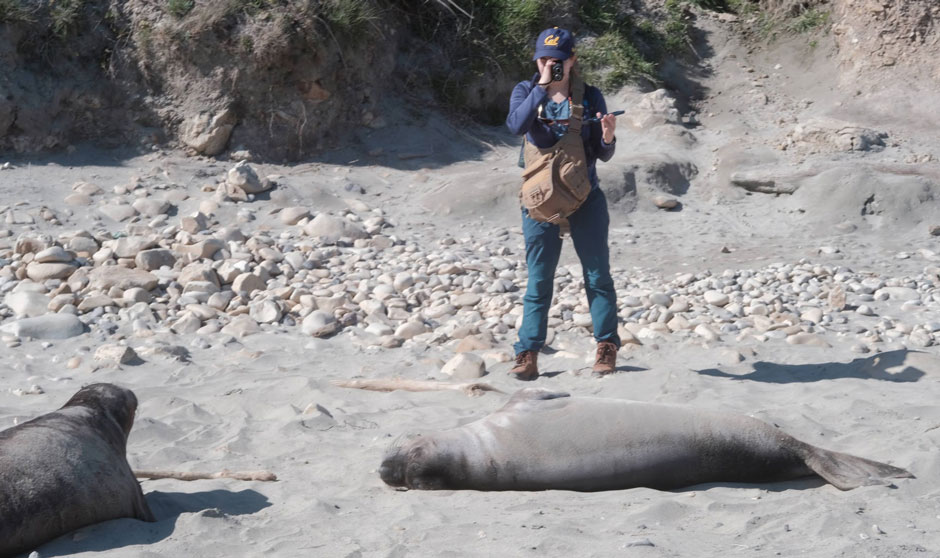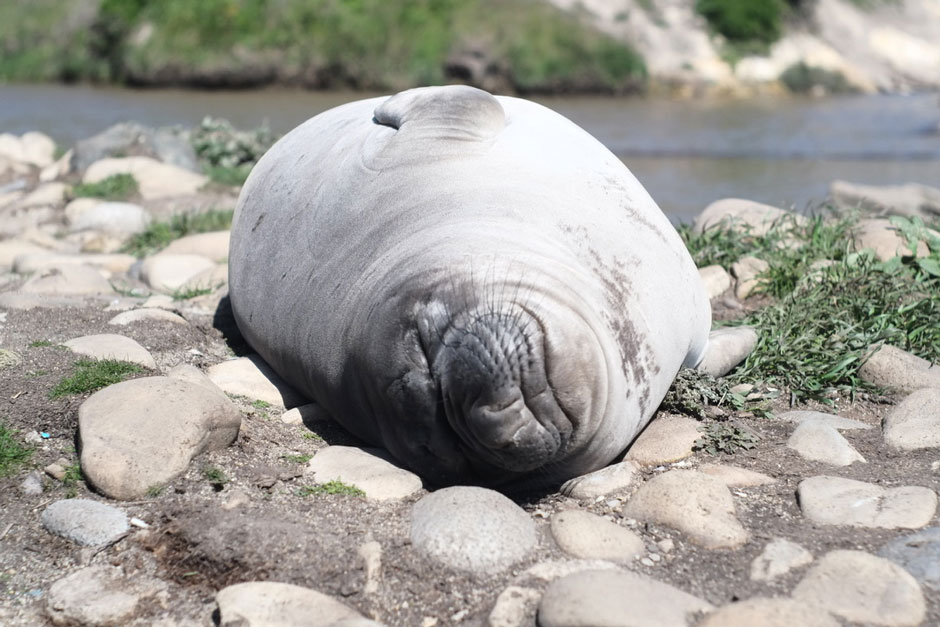Graduate Student Profile: Emily Lam
Endless Possibilities
By Kirsten Mickelwait
|
|
Growing up just north of the San Francisco Bay, Emily Lam always loved exploring the tide pools and beaches of the nearby coastline. After receiving her bachelor’s degree from DePaul University, she spent several years volunteering at the Marine Mammal Center in Sausalito before shifting her focus to studying the thermal physiology of crabs for her master’s at San Francisco State University. But a lecture on elephant seal physiology by biologist José Pablo Vázquez-Medina, who was about to join the faculty of UC Berkeley, brought her interest back to marine mammals. She is now a third-year PhD student in the Vázquez-Medina lab.
“He’s so open to new ideas,” Lam says of her PI. “And because we’re his first cohort, we’re really able to shape the lab culture and are motivated to try different things. It feels like there are endless possibilities to pursue with our research.”
When it comes to Lam’s own work, that may be a bit of an understatement. Her research projects take three very distinct directions, each of them studying how marine mammals are impacted by rapid environmental changes caused by human activities.
In one, Lam is looking at chronic stress exposure in baleen whales, which have traditionally been difficult to study because they’re fully aquatic and extremely large. Previous studies have only provided snapshots of physiology based on hormone measurements or stranding events. Lam hopes to develop a model using cultured cells taken from the skin of living whales.
Using that platform to conduct experimental stress manipulations, she then plans to compare whale cells to elephant seal cells—more is known about the physiology of the latter mammal because they’re semi-aquatic and, therefore, accessible on land. “We’re able to use whole organism evaluations to understand how they respond to stressors,” Lam says, “so we have a comparative framework to get at some of the more mechanistic underpinnings of their physiology.” With help from collaborators, she has collected skin cell samples from whales in Baja California, La Paz, and Half Moon Bay.
 NMFS Permit Number 21425. Biologists have been trained to safely do their research around the seals and reduce the possibility of disturbing the seals. |
In another research project, Lam studies the responses of northern elephant seals to global climate change and habitat degradation. Being semi-aquatic, these animals face unique thermal challenges: they need to insulate themselves while diving in frigid waters, but then they haul out on land where it can become very hot. “The concern isn’t necessarily the warming of the ocean water,” Lam says. “It’s that they have a greater challenge of off-loading heat while on land.” The seals no longer have access to cool refuges because their habitats on land are warming due to sand loss from storms caused by climate change.
Using thermal imaging analysis, she plans to study the thermoregulatory physiology of elephant seals—the ability to maintain their core internal temperature across different sites that range from cold and aquatic to hot and sandy. One example is a colony of elephant seals that seems to be relocating from the Farallon Islands to Drakes Beach at Point Reyes National Seashore. Lam wants to confirm the previous hypothesis that, due to several extreme storm events, the sandy Farallon beaches have washed away and forced the colony’s migration. She’s also looking at how climate change—including sea-level rise or increasing temperatures—will affect these creatures that rely heavily on thermoregulation. For this work, Lam travels to the Southeast Farallon Island, Point Reyes, and Año Nuevo State Park near Pescadero.
Lam’s third research area is more of a clinical study—with Professor Daniela Kaufer and her colleagues—and concerns the development of epilepsy in California sea lions after ingesting harmful algal blooms. Such blooms—the result of agricultural run-off or warming ocean temperatures—contain excitotoxins, which are substances that can damage neurons and cause brain lesions. “This pathology is really similar to temporal lobe epilepsy in humans,” Lam says. “Professor Kaufer’s hypothesis is that it’s causing dysfunction of the blood–brain barrier.” This may provide a good model to understand pathologies in humans because sea lions have structurally complex brains similar to our own.
 |
For Lam, her work in the Vázquez-Medina lab offers the best of two worlds—using biomedical technologies to understand physiology in less studied species as well as observing and interacting with the animals in the field. “We’re not just looking at a test tube; we know exactly where that sample came from,” she says. “There’s this nice bridge between field biology and technical molecular biology.”
Lam’s work has been funded by the Department of Defense National Defense Science and Engineering Graduate Fellowship Program and the Carol Baird Graduate Student Award for Field Research. Beyond Berkeley, she hopes to dive deeper into each of her three research areas with postdoctoral work. After that, who knows? “I’d be happy working in any field—whether it’s academia, research, or industry—as long as I can continue my research and working with the animals,” she says.
Back to Main Spring 2021 Newsletter Page








